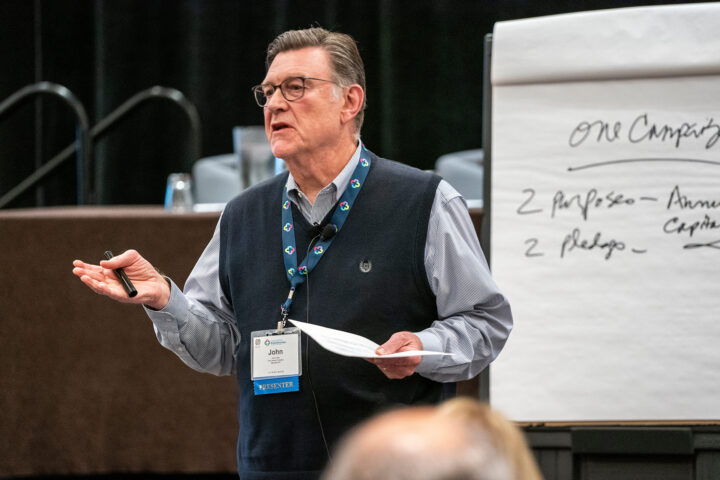9/26/2023
미니 캐피탈 캠페인 최대한 활용하기
by 낸시 크로우

Your church’s boiler gave up the ghost. The parking lot needs to be resurfaced. A tornado took off part of the church’s roof. Or maybe your Session wants to help the community with low-income housing.
All of these are candidates for a mini capital campaign, said John Clark, President of The James Company. His presentation, “What is a Thimble-Sized Capital Campaign?” was one of the workshops at 스튜어드십 만화경 in Minneapolis Sept. 25 to 27. Stewardship Kaleidoscope is an annual conference on generosity and stewardship. It is sponsored by the 장로교 재단.
To get the most out of a mini capital campaign — also called a special appeal — remember small isn’t all.
One time, at the right time
Mini campaigns are not the same as full-scale capital campaigns, which typically are conducted by professional consultants. Usually a significant renovation or other project is involved, requiring a giving commitment over a period of about three years.
“That’s the big stuff,” Clark said.
Instead, a mini campaign provides an opportunity for members and friends of the church to make a one-time contribution for a specific, smaller-scale purpose. Building needs, mission or ministry efforts and natural disaster responses are common targets.
“The key here is one-time,” Clark said. “The other key is that it’s over and above current giving. What makes this work is, it’s compelling and it’s urgent.”
That’s why mini campaigns lose effectiveness, and can eat into your annual appeal, if they’re held too often. Members may start regarding them as just another way to get more money, Clark said. Once every three years is plenty.
What do you need?
Mini capital campaigns take planning, leadership, communication and asking, Clark said.
To help potential donors think through their gifts, he suggested providing them with a giving chart listing what is needed:
- One gift of 10% of the goal
- One gift of 7% of the goal
- Three gifts of 5% of the goal
The top gifts will get things moving, ensure the feasibility of the project and raise the confidence of the congregation, Clark said. “Otherwise you’ll have doubting Thomases who wait and see.”
Also: “Challenge gifts can work beautifully.”
The hard part: Asking
As with any giving campaign, actually getting the gifts is another matter.
Make the case, ask people to prayerfully consider supporting the project and show them what’s needed. “Ask what is feasible for them,” Clark advised.
If asking someone personally, Clark suggested this be done in the person’s home, at the church or over Zoom if face-to-face isn’t possible. Usually the pastor and a lay leader, or two lay leaders, should do the asking — but no more than two, he said. You don’t want potential donors to feel ganged up on.
How, a participant asked, do you identify potential lead donors without violating privacy around giving?
It depends on the project and the interests of potential donors. Clark suggested a church leader say, for example: “You’re very active and supportive of the congregation, and we believe you might have a heart for this project.”
Whether the pastor has access to members’ giving information is another factor. It can also depend on instinct, which Clark admitted can be incorrect. He offered this example: A pastor who did not know what members gave approached a church member for a lead donation. The person owned what the pastor thought was a lucrative small business. However, when asked, the member laughed — then politely declined.
In any case, do not ask for a response on the spot, Clark said. He also doesn’t recommend using a mini campaign to correct a budget shortfall; that sets a bad precedent and doesn’t solve the problem.
Getting it done
Keep it clear, concise, compelling and urgent, Clark emphasized. Contributions should be straight-up gifts and not pledges.
“It really needs to be one and done,” he said.
Clark walked participants through a sample mini campaign to raise $100K, or more, in eight weeks. The campaign begins with forming a leadership team, culminates in a Gift Sunday and follows up with thank-you notes and sharing how gifts are being used.
“Keep building confidence week to week,” he said. “Stewardship is a combination of a science and an art.”
